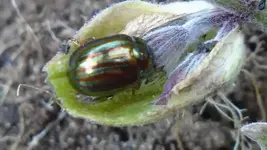Sheal
Well-known member
- Location
- Ross-shire Scotland
- Hardiness zone
- 8a

According to a French recipe from the 1800s, a batch of cockchafer soup requires 500 grams of the insect with their legs and wings removed. They are fried in butter, then cooked in a chicken or veal broth. The soup can be strained and eaten as a boullion, or crushed cockchafers can be mixed with egg yolk and roux.
Nope, you'll eat the bugs and like it.Yeah, so I'll pass on that course, thank you!
Now who was it that said ''You will have nothing and be happy''Nope, you'll eat the bugs and like it.
Right on both counts @Tetters.I think that's a female spotted woodpecker isn't it. The male has a red spot on the top of his head I believe. I looked up the black/blue monster, and think it's an oil beetle. https://www.independent.co.uk/climate-change/news/hunt-launched-for-oil-beetles-2252749.html
I caught the cat batting this around
@Sheal what kind of lens are you using to get zoomed in on the woodpeckers like that?

Oh deer it looks like it has antlers.
The French eat some pretty strange things. I can't say I'm keen on things that are crunchy on the outside.
Fast Facts. Common cockchafer males can easily be distinguished from the females by counting the number of 'leaves' on their remarkable antler-like antennae, males sport seven 'leaves' while females have only six. These leafy antennae can detect pheromones, enabling males to find females even in the dark!
this is one of two cameras I have, a Canon SX50. In Britain we know it as a Bridge camera and has a prime lens.

These brightly coloured beetles are a common sight in many parks and gardens across the UK. As the name suggests, they feed on the leaves of herbs including rosemary, thyme, and lavender. They can often be found in large numbers on their host plants. They feed busily in spring, but become less active in the warmest months of mid summer. They start feeding again in late summer, when females lay tiny, sausage-shaped eggs on the underside of the leaves. After hatching, the grey, slug-like larvae also feed on the leaves of herbs. When they're fully grown, the larvae travel down the plant and into the soil to pupate. They emerge as adults in spring, ready to start the cycle all over again. Adults can be present all year.
Rosemary beetles have not always been found in the UK. They are native to the Mediterranean region of southern Europe, North Africa, and the Middle East. The shipping of herbs around Europe has helped them spread to new countries. The first rosemary beetle in the UK was found in Cheshire in 1963, then three more were discovered in Surrey in 1994. After that they quickly spread and became common around London. Now they are found widely across all countries of the UK.
